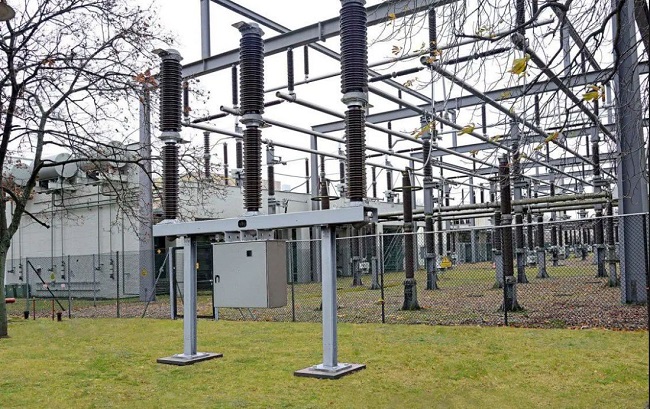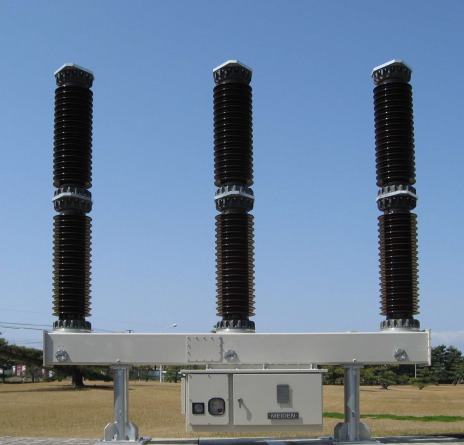
Introduction about high voltage vacuum circuit breakers:
Apart from the technology of arc quenching and insulation with SF6-alternative gases, replacement of SF6 can also be done with vacuum circuit breakers.
Since 2014 high voltage vacuum circuit breakers as alternative switching equipment for high voltage gas circuit breakers are given.
Vacuum switchgear has been in extensive use in distribution systems for 30 years for the making and breaking of fault current and the switching of loads of all possible nature. The reliability and performance records of the vacuum switching technology are outstanding in the medium voltage range (up to 52 kV), which has led to the domination of vacuum switching technology in distribution systems.
We have already explained how to cut spark in a vacuum and SF6 gas here.
Already in the 1960s, efforts have been made to extend the application of vacuum switching technology to the transmission voltage level. Around 1980, high-voltage vacuum circuit breakers (HV VCB, high voltage here defined as above 52 kV) were put in service in Japan and by 2010, around 10 000 high voltage vacuum circuit breakers were installed, mainly in industrial applications, but also in utility applications. The reason for preferring vacuum technology in favor of SF6 was mainly the capability to switch very frequently and/or the lower maintenance costs compared to SF6. The voltage level of installed switchgear is (with few exceptions) at present limited to 72/84 kV and the technology is almost exclusively metal-enclosed. Reliability studies (on a limited population of circuit breakers) show similar reliability for high voltage vacuum circuit breakers and HV SF6 switchgear of the same rating.
In the US, vacuum capacitor bank switches have been used for a few decades up to 242 kV. Around 2008, intense R&D programs started in China and Europe in order to develop HV VCB. In this case, the main driver is the absence of SF6 gas, recognized as a very strong greenhouse gas. This led to a number of products and applications with voltages up to 145 kV. In China, the rapid growth of application in commercial operation is foreseen with at present (2013) some hundreds of high voltage vacuum circuit breakers in service up to a voltage level of 126 kV. In Europe, field tests are being carried out on type-tested devices before the new products come to the market.
All high voltage vacuum circuit breaker products are based on medium voltage vacuum circuit breaker interrupter technology. , No essentially new technical features were necessary. The main extrapolation is in the geometry of the interrupter that has to be designed in order to deal with the higher voltage rating e.g., by increasing the diameter and the contact gap length. In some cases, for voltages above 126 kV, two vacuum gaps in series are applied.
Both vacuum and SF6 technology are equally well suited to handle the standardized duties related the fault- and load current switching. Nevertheless, because of the fundamentally different principles of current interruption there exist certain differences which are relevant to application in high voltage systems.
High voltage vacuum circuit breaker operational features:
▪With regard to normal currents up to 2500 A, there are no significant differences, but above 2 500 A it is challenging to realize in high voltage vacuum switchgear such normal current ratings. This is due to a number of reasons, the heat generation by the vacuum circuit breaker contact structure and the limited heat transfer capability of the interrupter.
▪It is easier to check the quality of the interruption medium in the case of SF6 circuit breakers. It is not practical to monitor the required degree of vacuum in service.
▪The number of possible switching operations is higher with vacuum than with SF6 due to the higher endurance of the VCB contact system to arcing. This makes vacuum attractive in applications requiring (very) frequent switching operations, such as daily operations.
▪At a typical 72.5 kV rating, the drive energy of the vacuum circuit breaker may be as low as 20% of that of the equivalent SF6 circuit breaker. The sizes of the vacuum and SF6 devices are comparable.
▪A high voltage vacuum circuit breaker may need more than one interrupter in series above 145 kV. In SF6 technology, single break CBs up to 550 kV have been put in service since 1994 and are widely installed in many countries.
▪ There is a large difference in physics between the technologies. For example, the arc voltage of VCB is much lower than SF6 CB, several tens of volts against several hundreds of volts. Also, the duration of the arc in fault switching is shorter in vacuum switchgear as the minimum arcing time in HV VCB is typically 5–7 ms against 10–15 ms for SF6 CB. The consequence of this is that the number of possible switching operations of VCB is generally significantly higher than for SF6 CBs.
▪X-ray emissions from HV VCBs with rated voltage ≤ 145 kV are within the standardized limits of 5 µSv/h under normal operating conditions. SF6 circuit breakers do not emit x-rays.
High voltage vacuum circuit breaker electrical features:
▪ Interruption of fault current with an associated very steep rate-of-rise of transient recovery voltage is superior to vacuum interrupters because of their very fast dielectric recovery, compared to SF6.
▪ The breakdown statistics of vacuum and SF6 gaps differ. Although a vacuum gap in principle has a very high breakdown voltage, there remains a very small probability of breakdown at relatively moderate voltage.
▪ Vacuum gaps are known to show spontaneous late breakdown, up to some hundreds of ms after current interruption. However, the consequences of such an event are very limited because the vacuum gap immediately restores its insulation. Its system implications are not fully understood yet.
In case of a late breakdown of an SF6 gap, which is extremely rare, the gap generally cannot recover.
▪ In inductive load switching, notably, shunt reactor switching, the number of repeated re-ignitions (at one power frequency current zero) is significantly higher in a vacuum than in SF6. This is due to the capability of the vacuum to interrupt the high-frequency current that follows re-ignition. The consequences of this for apparatus interacting with the re-ignition transients are presently unknown. For example, RC snubbers and metal-oxide arresters may be applied to mitigate this.
▪ When switching capacitor banks with vacuum switchgear, very high inrush current must be avoided. This is because the contact system can be dielectrically deteriorated by the pre-strike arc. This duty is a challenge also for SF6. Mitigation can be accomplished by insertion of a series reactor or controlled switching, although there is no field experience with the latter technology for HV VCB.
High voltage vacuum circuit breakers futures and conditions:
An inquiry was set up to question users of HV switchgear on the assumed strengths and weaknesses of both technologies for application in their HV system. Around 120 replies from 28 countries were received. The vast majority see the absence of SF6 as the main advantage of vacuum switchgear (provided that the external insulation is SF6-free). At the same time, the lack of service experience at the transmission voltage level was mentioned as a major hesitation for the HV vacuum circuit breaker application.

Photo from Meidensha company (145kV Insulator Type Vacuum Circuit Breaker)
Generation of an overvoltage by current chopping and the possibility of x-ray emission in switching in vacuum was referred to frequently by potential users. Up to and including a rated voltage of 145 kV x-ray emission (in single break devices) remains below the standardized value of 5 µSv/h under normal operating conditions. Multiple break devices have lower levels.
A large majority of the respondents wish to start a pilot project with a high voltage vacuum circuit breaker in their system in order to gain experience with vacuum technology.
Regarding standardization, it is recognized that the present IEC circuit breaker standard IEC 62271-100 has a strong focus on SF6 switching technology. Test duties that are known to be challenging for SF6, such as short-line fault tests, may not be critical for vacuum. On the other hand, the application of continuous recovery voltage in synthetic testing may not be relevant for SF6 but may be considered for vacuum, regarding the demonstration of the absence of a late breakdown.
Since the network conditions of medium voltage networks are not always comparable to transmission voltage networks (i.e., earthing conditions), pilot projects in solidly earthed networks are recommended to gain the practical experience mentioned above.
In the case, where SF6 as an external insulating medium is absent, it has to be considered that other technical implications such as higher pressure, weight, footprint, etc. should be taken into account.
The manufacturers are continuously seeking alternatives to SF6 technology and are committed to making available any industrially viable replacement. However, SF6 technology will remain essential for the transmission networks until a new technology that can cover all ratings is found.




Dear sir,
We are interested in your products,
please reply back with email.
Thank you for your comment, I will contact you.